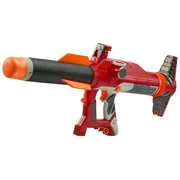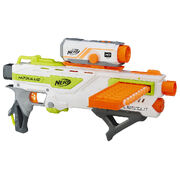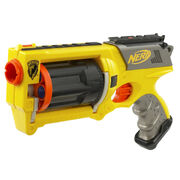An N-Strike number code helps tell how many darts a Nerf blaster has, how a blaster is loaded or fired, and what type of blaster it is. As the name states, number codes are used for N-Strike blasters, as well as some N-Strike Elite blasters.
List of N-Strike number codes
There are a few common codes in the names of N-Strike blasters:
Air system (AS)

The Hornet AS-6, an example of an AS blaster.
Main article: Air system
The Magstrike AS-10, Hornet AS-6, Secret Strike AS-1 and the Rapid Fire AS-20 are all air system blasters. When pumped, they store air within a tank or bladder, which is usually reserved for an all-out blast.
Air system vessel (AS-V)

The Titan AS-V.1, the only AS-V blaster.
Main article: Air system vessel
The Titan AS-V.1 is the only air system vessel in the N-Strike series. It is a lot like an air system blaster except that it is a lot bigger and can carry blasters on it, which is why vessel is added to the code.
Clip system (CS)

The Longshot CS-6, an example of a CS blaster.
Main article: Clip system
The Longshot CS-6, Longstrike CS-6, Recon CS-6, Raider Rapid Fire CS-35, Deploy CS-6, Rayven CS-18 and the Alpha Trooper CS-18 are clip system loaded blasters. All clips and drums are interchangeable between clip system blasters.
Integrated clip system (ICS)

The Battlescout ICS-10, an example of an ICS blaster.
Main article: Integrated clip system
The Battlescout ICS-10 and Rukkus ICS-8 are clip-loaded blasters that cannot be removed and index automatically. Despite their name, they are not compatible with clip system clips and drums.
Electronic belt-fed (EBF)

The Vulcan EBF-25, the only EBF blaster.
Main article: Electronic belt-fed
The Vulcan EBF-25 is the only electronic belt-fed blaster in the N-Strike series. It uses battery power to let the blaster fire automatically. The Vulcan can also be manually fired without battery power. The Vulcan uses a motorized direct plunger.
Electronic clip system (ECS)

The Stampede ECS, an example of an ECS blaster.
Main article: Electronic clip system
The Stampede ECS and Cam ECS-12 are electronic clip system-feeding blasters. They can fire automatically or semi-automatically with battery power and, unlike the Vulcan, cannot be fired manually.
External single fire (EX)

The Nite Finder EX-3, an example of an EX blaster.
Main article: External single fire
The Nite Finder EX-3, Element EX-6, Jolt EX-1, Triad EX-3, and the Switch Shot EX-3 are single fire blasters. These blasters are muzzle loaded and get their name for having an external pull-back mechanism that is used to prime the blaster. These blasters are known by their extreme ranges due to their direct plungers.
Internal single fire (IX)

The Scout IX-3, an example of an IX blaster.
Main article: Internal single fire
The Scout IX-3, Reflex IX-1, and the Barrel Break IX-2 are internal single fire blasters. Much like its External Single Fire counterpart, these blasters are muzzle loaded. However, these blasters have internal priming mechanisms; instead of an orange ring pullback, and they have reverse plungers.
Revolver (REV)

The Maverick REV-6, an example of a REV blaster.
Main article: Revolver
The Firefly REV-8, Maverick REV-6, and the Spectre REV-5 are revolver system firing blasters. Both the Maverick and Firefly have prominent barrels that rotate when the blaster is fired. An exception of this is that Spectre's revolving system revolves when it is primed.
Electronic revolver (RV)

The Barricade RV-10, the only RV blaster.
Main article: Electronic revolver
The Barricade RV-10 is the only electronic revolver in the N-Strike series. It features a revolving barrel much like a regular REV blaster, but instead is fired by battery power.
Trivia
- Other Nerf blaster series have their own number codes.
- Zombie Strike Biosquad blasters have "ZR", followed a number; like RIVAL blasters, every 100 that follows the name represents how many darts can be loaded at a time.
- Dart Tag blasters made in 2011 and 2012 have a simple number in their name representing their max firing capacity.
- RIVAL blasters have number codes in their name. This number code is Greek numerals indicating its year of release, with an "M" denoting if a blaster is battery-operated and motorized. This is followed by the amount of High-Impact Rounds the blaster in question can hold; every 100 in a RIVAL blaster's name means how much High-Impact Rounds can be loaded.
